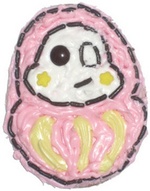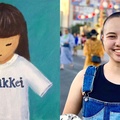Daruma are popular Japanese symbols of perseverance. Often used as good luck charms to fulfill a special wish, it’s customary to paint in the right eye when the wish is made, then paint the other eye when the wish is fulfilled.
It’s a traditional folk craft representing the 5th century Buddhist monk Bodhidharma who meditated so long that he lost the use of his arms and legs. Daruma dolls are often weighted on the bottom so that if tipped, they automatically find their balance and right themselves up again no matter how many times you push them down.
But, it’s not really supposed to be a wish…more like a resolution. A promise to oneself…
***
For a while now, I’ve been interested in the symbolism of the daruma. I suppose it’s part cultural curiosity, but interest also lies in what it represents—persistence, determination, and inner strength. I have even occasionally created my own interpretations. Years ago, I did a painting of three daruma (the first with no eyes painted in, the middle with one eye painted, and the third with both painted in) as part of a series of pieces featuring Japanese cultural icons.
One winter when I used to work in the Japanese American National Museum’s Store, I wanted to make “awards” for the volunteers who had put in the most amount of time during the busy holiday season and throughout the year. I made a bunch of little paper mache daruma (my first attempt at making paper mache ever). It was a lot of work and took much longer than I had anticipated, but the satisfaction that I got was well worth it in the end.
My next daruma was a cookie. At work, as a fun spring-time activity, we were invited to decorate cookies one year. I got inspired and decided to use an Easter egg-shaped cookie to make a daruma. Most recently, I got a bit carried away as usual and carved a daruma pumpkin this Halloween [check out my Nikkei Album collection to see photos of my various interpretations: My Collection of Daruma].
***
The symbolism of daruma is something that I’ve been feeling an especially strong connection to lately. The world seems to be in disarray. Although the election of Barrack Obama has given me great hope, I know that the road ahead is daunting and will likely take years to make significant, real change…but I believe that even a little glimmer of hope is important to hold in your heart.
Working at a non-profit organization during these times of economic upheaval is very difficult. I’ve worked at the Museum for the last 13 years, and seeing projects cut and people leave has been tremendously difficult. Living with uncertainty of the future has been very trying. I’ve been told that I should face reality and update my resume, be prepared, but it just breaks my heart.
I’ve come to realize that what I’ve been feeling is truly grief over the loss of what used to be and the uncertainty of what will come. Frustration, inadequacy, feelings of failure over my inability to prevent things from happening, even though I know most of it is completely beyond my control.
They say there are five stages of grief: 1) denial, 2) anger, 3) bargaining, 4) depression, and finally 5) acceptance. Looking over the past few months, I realize that I have gone through stages one through four. I think in writing this, I am finally getting to stage five.
***
Lately, I’ve been consuming vast amounts of Japanese dramas online. When depressed, some people may turn to excesses of alcohol, drugs, gambling or other forms of abuse. For me, apparently, it’s Japanese dramas (dorama). I’ve watched them to the detriment of my health, work, and relationships…constantly consuming show after show after show…I realize that I’m using them to escape my reality. I know that, and yet I haven’t been able to stop over the last few weeks.
I think it’s that I’ve been so desperate for happy endings…to know that in the end it’ll be okay. It’s also an outlet for emotional release. I feel like I need to be strong and not cry about what’s going on in my life…but it’s okay to cry about a fictional character’s loss. It’s a way to vicariously release without having to admit what I really need to cry about.
But, I think this obsessive turning to Japanese dorama is also more. In them, they teach moral lessons…to never give up (gambatte). By sticking together with your friends and colleagues (nakama), you can overcome obstacles and change the future. I think for me, from these shows I look for inspiration and hope.
These kinds of spirit and character traits are what enabled the Issei and Nisei to overcome so many seemingly hopeless situations, frustrations, and loss. “Gaman,” “shikata ga nai,” “gambatte,” “kodomo no tame ni”…these were the things that helped them overcome the Great Depression and what happened during World War II. I guess this is our time to see if we can live up to their examples.
It’s time for me to not only get to acceptance, but to move forward. I'm going to try to look at it as an opportunity to do things differently, look towards innovation and creativity to find new solutions.
Today I will paint in the right eye of a new daruma that I will keep at my desk. I will work hard with my friends and family so that I WILL be able to proudly paint the other eye in…my goal, my dream, my sincerest wish, my hope for the future…
© 2008 Vicky Murakami-Tsuda








